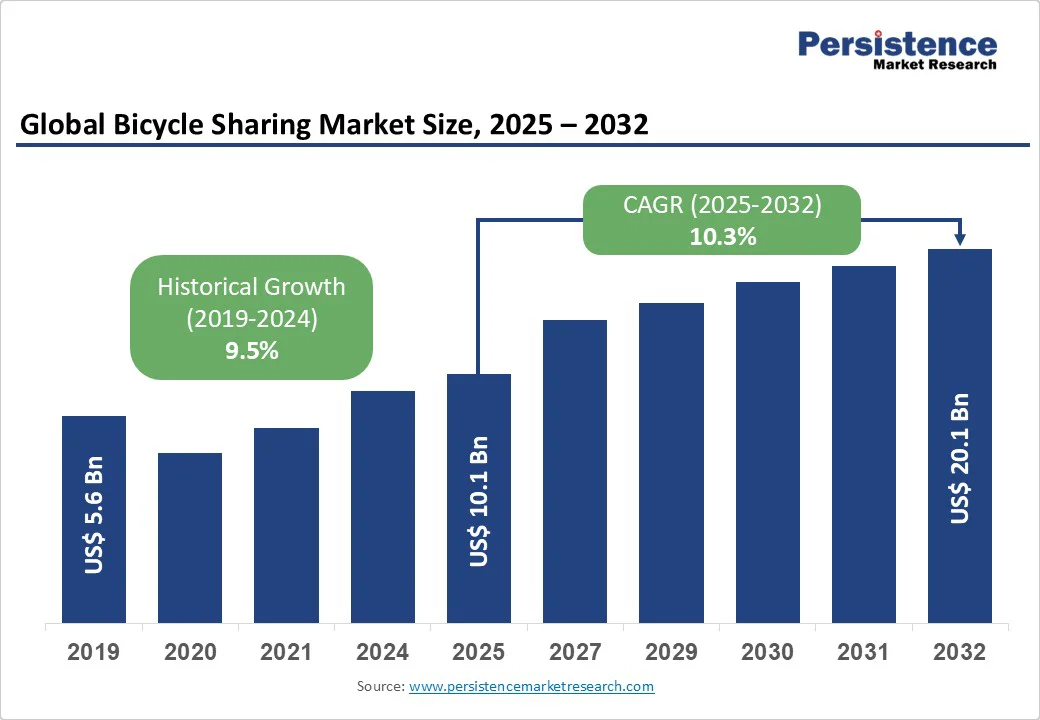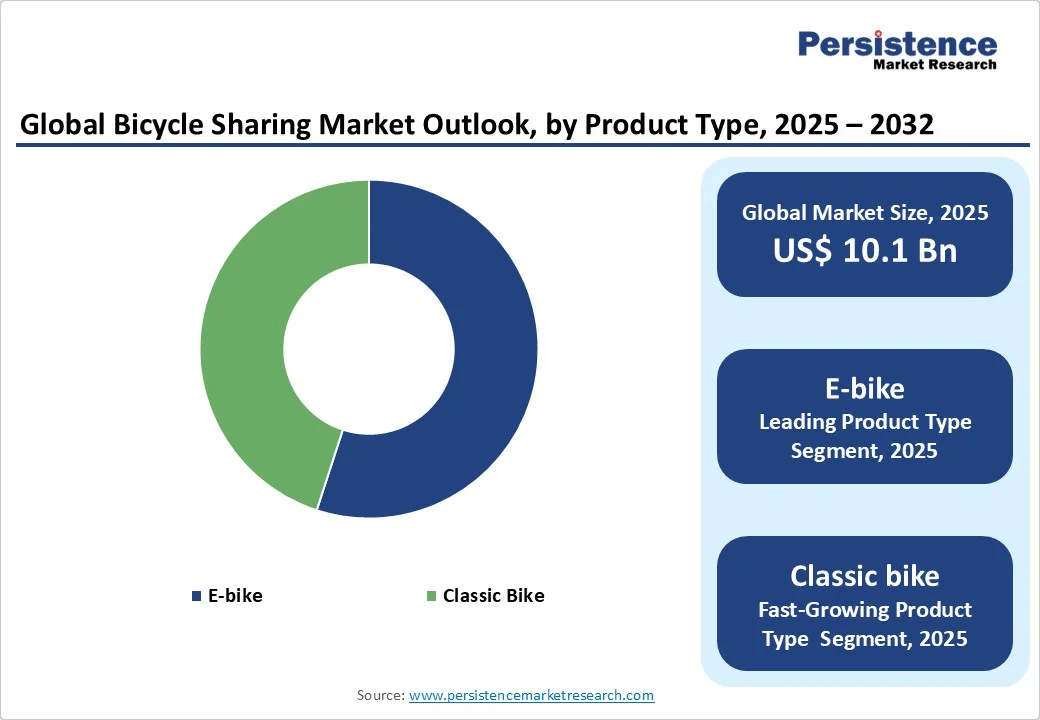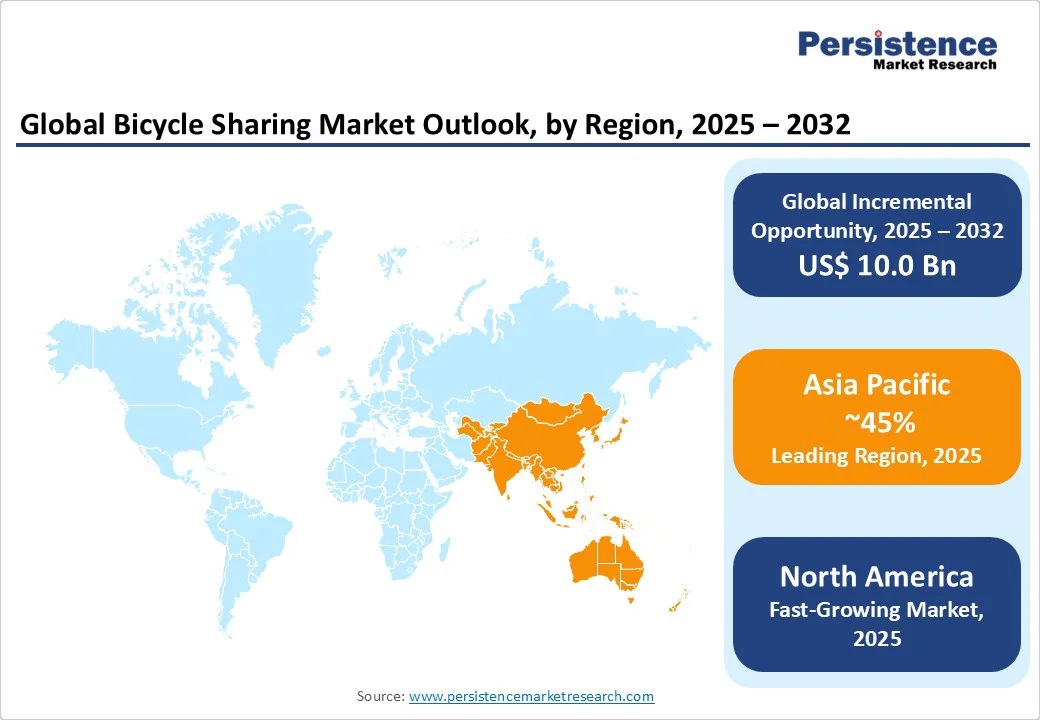ID: PMRREP31609| 189 Pages | 26 Sep 2025 | Format: PDF, Excel, PPT* | Automotive & Transportation

The global bicycle sharing market size is likely to be valued at US$ 10.1 Bn in 2025 and is estimated to grow to US$ 20.1 Bn by 2032, growing a CAGR of 10.3% during the forecast period from 2025 to 2032.
The bicycle sharing market is experiencing robust growth, driven by rising urbanization, increasing environmental awareness, and advancements in smart mobility solutions.
| Key Insights | Details |
|---|---|
| Bicycle Sharing Market Size (2025E) | US$ 10.1 Bn |
| Market Value Forecast (2032F) | US$ 20.1 Bn |
| Projected Growth (CAGR 2025 to 2032) | 10.3% |
| Historical Market Growth (CAGR 2019 to 2024) | 9.5% |

The bicycle sharing market is propelled by rapid urbanization and the global push for sustainable transportation. In 2025, over 2,000 cities worldwide adopted bike-sharing systems, with Asia Pacific accounting for 70% of global deployments, driven by initiatives such as China’s National Urban Transport Plan, which invested US$ 15 Bn in cycling infrastructure. This is justified by the need to reduce urban congestion; for instance, Beijing’s traffic delays dropped 12% in areas with dense bike-sharing networks.
Technological advancements, particularly IoT and GPS integration, significantly drive market growth, enabling real-time bike tracking and reducing theft by 30%. Mobile app platforms, integrated with digital payment systems, enhance user convenience, with 85% of users preferring app-based access over physical kiosks.
Government policies amplify this driver; the EU’s Green Deal, allocating €20 Bn for urban mobility by 2030, mandates cycling infrastructure in 300+ cities, spurring a 15% increase in bike-sharing adoption in Europe. In India, the Smart Cities Mission, with US$ 10 Bn in funding, has deployed 500,000 shared bikes across 100 cities, targeting last-mile connectivity.
High operational and maintenance costs pose significant restraints to the bicycle sharing market, with annual maintenance for a single bike averaging US$ 200-300. Vandalism and theft, particularly in dockless systems, result in 10-15% fleet losses annually, costing operators such as OfO US$ 50 Mn in 2025. Infrastructure challenges, such as limited bike lanes in 60% of developing cities, deter adoption, with accidents rising 8% in areas lacking dedicated paths.
Regulatory hurdles further constrain growth; inconsistent municipal policies, such as permit delays in Southeast Asia, have stalled 25% of planned expansions in 2025. Economic volatility, with global inflation at 5.5% in 2025, reduces consumer spending on subscriptions, impacting revenue for operators such as Zagster.
The skills gap for IoT maintenance in emerging markets leads to 20% higher downtime, particularly in Africa and Latin America. These restraints highlight the need for cost-effective solutions and infrastructure investments to sustain the markets.
The bicycle sharing market offers significant opportunities through smart city integration and technological advancements. The global smart city market integrates bike-sharing with IoT platforms, enabling dynamic fleet management and 20% efficiency gains. Government incentives, such as the U.S. Bipartisan Infrastructure Law’s US$ 66 Bn for urban transport, promote bike-sharing in 200+ cities, creating demand for e-bikes.
Emerging markets in Africa and Southeast Asia, with urban growth rates of 4% annually, present untapped potential; Nigeria’s Lagos plans 10,000 shared bikes by 2027. Innovations such as solar-powered e-bikes and AI-driven route optimization, reducing travel time by 15%, open new revenue streams. Partnerships with public transit systems, as seen in Japan’s rail-bike integrations, boost ridership by 30%. These opportunities position the market for exponential growth beyond 2032.
E-bike dominates the product type segment, expected to hold approximately 60% share in 2025, driven by its appeal for longer commutes and ease of use in hilly terrains. E-bikes, equipped with electric motors, enable 20-30% faster travel compared to classic bikes, boosting adoption among urban professionals.
Their dominance is further supported by battery advancements, extending range to 50 km per charge, and government subsidies. E-bikes’ integration with IoT for battery monitoring reduces downtime by 20%, making them ideal for high-demand urban corridors.
Classic bike is the fastest-growing product type, driven by affordability and simplicity for short urban trips. Classic bikes, costing 40% less to deploy than e-bikes, appeal to budget-conscious cities in India and Southeast Asia, where dockless systems have expanded classic bike fleets by 30%. Their growth is fueled by infrastructure investments, such as Amsterdam’s €200 Mn bike lane expansion, and rising eco-consciousness among millennials, with 40% of users preferring non-motorized options for sustainability.
Pay-as-you-go leads the payment method segment, commanding approximately 55% share in 2025, due to its flexibility for occasional users and tourists. This model, supported by mobile apps with QR-code access, accounts for 70% of trips in cities such as Shanghai, with transaction volumes reaching US$ 2 Bn in 2025. Its dominance is driven by low entry barriers, with rides costing US$ 0.5-1, and integration with digital wallets, boosting usage by 25% in North America.
Subscription-based is the fastest-growing payment method, fueled by loyalty among daily commuters and corporate partnerships. Subscriptions, offering unlimited rides for US$ 10-20 monthly, increased by 22% in Europe in 2025, as employers subsidize plans for ESG compliance. Integration with transit passes, as seen in Tokyo’s Suica system, drives 30% higher retention, accelerating adoption.
Dockless services dominate the segment, holding over 55% share in 2025, driven by their flexibility and scalability in urban settings. Dockless systems, enabled by GPS and IoT, allow bikes to be parked anywhere, resulting in a 40% reduction in infrastructure costs compared to docked systems. In China, OfO reported 1.5 Bn dockless trips in 2025, with 80% in tier-1 cities. Their dominance is supported by rapid deployment, with 500,000 bikes added in India, and user convenience, cutting access time by 50%.
Docked is the fastest-growing service, driven by structured urban planning and safety regulations. Docked systems, requiring fixed stations, ensure organized parking, reducing vandalism by 25% in cities such as New York. Investments in smart docking stations, such as PBSC Urban Solutions’ solar-powered hubs, boost adoption by 20% in Europe, particularly in regulated markets demanding controlled bike placement.

North America holds a significant position in the bicycle sharing market, with a 20% share in 2025, driven by urban mobility initiatives and sustainability goals. The U.S. leads with investments such as the Bipartisan Infrastructure Law’s US$ 66 Bn for urban transport, deploying 200,000 shared bikes across 50 cities by 2025. Canada’s Toronto Bike Share added 5,000 e-bikes, supported by CAD 200 Mn in municipal funding.
Trends include AI route optimization, reducing congestion by 15%, and integration with transit apps, boosting ridership by 25%. A key trend in North America is the shift toward dockless systems, which now account for 60% of new deployments, reducing infrastructure costs by 40% compared to docked systems.
However, challenges such as vandalism, costing operators US$ 10 Mn annually, and limited bike lane coverage in smaller cities persist. Supply chain localization in states such as California mitigates 15% cost increases from global disruptions, ensuring affordability
Europe is a key market, with a 25% share in 2025, driven by cycling culture and stringent environmental policies. Leading countries such as the Netherlands, Germany, and the U.K. fuel growth; the Netherlands’ €500 Mn bike lane expansion supports 1 Mn shared bike trips daily. Germany’s Call a Bike, grew 18% in 2025, driven by e-bike subscriptions.
The U.K. market trends show a 9.5% growth rate, with London’s Santander Cycles deploying 15,000 bikes, boosted by the U.K.’s £2 Bn Active Travel Fund and post-Brexit urban planning prioritizing net-zero. Offshore wind workers’ use of shared bikes for port commuting adds 10% to demand.
The EU’s Green Deal mandates 30% cycling share in urban transport by 2030, with docked systems gaining traction in regulated cities. innovations such as blockchain for secure bike access and AI for predictive fleet rebalancing, reducing downtime by 25%, enhance Europe’s market resilience.
The region’s focus on circular economy principles, with 70% of bike components recyclable, aligns with sustainability mandates, positioning Europe as a leader in structured, eco-driven bike-sharing growth.
Asia Pacific dominates the bicycle sharing market, with a 45% share in 2025, driven by massive urban population and smart city initiatives. China leads with 5 Mn shared bikes, supported by US$ 15 Bn in cycling infrastructure. India’s Yulu deployed 300,000 bikes across 10 cities, backed by the Smart Cities Mission.
Japan’s Hello-Bike integrates with rail systems, boosting ridership by 30%. The region is fueled by e-bike adoption, with 70% of China’s fleet electrified, and dockless systems, reducing urban emissions by 10 Mn tons annually. Geopolitical drivers, such as China’s Belt and Road Initiative, promote bike-sharing in Southeast Asia, with Vietnam and Indonesia adding 50,000 bikes by 2025.
Challenges such as vandalism, costing US$ 20 Mn annually in India, and limited infrastructure in tier-2 cities persist. Supply chain hubs in Singapore and Shenzhen reduce component costs by 15%, while Japan’s focus on seismic-resistant docking stations addresses natural disaster risks. Asia Pacific’s blend of scale, affordability, and innovation ensures it remains the market’s growth engine, unlocking US$ 12 Bn in revenues by 2030.

The global bicycle sharing market is highly competitive, with players focusing on technological innovation and sustainability to capture market share. Key companies include OfO, Mobike, Beijing Xiaoju Technology Co. Ltd., Meituandianping Inc., Zagster, Hello-Bike, PBSC Urban Solutions, Donkey Republic, Motivate Inc., Nextbike GmbH, Flick Bike, Urbo Solutions, holding over 65% market share through extensive fleets and digital platforms.
Firms invest in IoT and AI for fleet management, pursue partnerships with transit authorities, and develop eco-friendly e-bikes to align with sustainability goals and expand in emerging markets. Companies are heavily investing in the development and deployment of eco-friendly e-bikes and hybrid models, aligning with global sustainability goals and the growing emphasis on reducing carbon emissions.
Expansion into emerging markets across Asia-Pacific, Latin America, and Africa offers significant growth opportunities, driven by rapid urbanization, rising environmental concerns, and supportive government initiatives for smart and green mobility solutions.
The global bicycle sharing market is projected to reach US$ 10.1 Bn in 2025.
Urbanization, environmental awareness, and IoT-enabled bike-sharing systems drive the market, supported by government sustainability initiatives.
The bicycle sharing market is expected to grow at a CAGR of 10.3% from 2025 to 2032.
Smart city integration and AI-driven fleet management offer opportunities for scalable, eco-friendly bike-sharing solutions.
OfO, Mobike, Meituandianping Inc., PBSC Urban Solutions, and Nextbike GmbH are key players.
| Report Attribute | Details |
|---|---|
| Historical Data/Actuals | 2019 - 2024 |
| Forecast Period | 2025 - 2032 |
| Market Analysis | Value: US$ Bn, Volume: As Applicable |
| Geographical Coverage |
|
| Segmental Coverage |
|
| Competitive Analysis |
|
| Report Highlights |
|
By Product Type
By Payment Method
By Service
By Region
Delivery Timelines
For more information on this report and its delivery timelines please get in touch with our sales team.
About Author